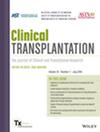Obesogenic Medication Use in End-Stage Kidney Disease and Association With Transplant Listing
Abstract
Objectives
Obesogenic medications are a putative contributor to the obesity epidemic. While 20% of adults take ≥1 obesogenic medication, the proportion in the end-stage kidney disease (ESKD) population—a group enriched for cardiometabolic complications—is unknown. Obesogenic medications may contribute to obesity and hamper weight loss efforts to achieve transplant listing.
Methods
Using 2017–2020 USRDS and Medicare claims, patients were identified as taking obesogenic medications if prescribed anticonvulsants, antidepressants, antidiabetics, anti-inflammatories, antipsychotics, and/or antihypertensives known to cause weight gain for ≥30 days in their first hemodialysis year. Ordinal logistic and Cox regression with inverse probability of treatment weighting were used to quantify obesogenic medications’ association with body mass index (BMI) and listing, respectively.
Results
Among 271 401 hemodialysis initiates, 63.5% took ≥1 obesogenic medication. For those in underweight, normal weight, overweight, and class I, II, and III categories, 54.3%, 58.4%, 63.1%, 66.5%, 68.6%, and 68.8% took ≥1, respectively. Number of obesogenic medications was associated with increased BMI; use of one was associated with 13% increased odds of higher BMI (aOR [adjusted odds ratio] 1.14; 95%CI: 1.13–1.16; p < 0.001), use of three was associated with a 55% increase (aOR 1.55; 95%CI: 1.53–1.57; p < 0.001). Any use was associated with 6% lower odds of transplant listing (aHR [adjusted hazard ratio] 0.94; 95%CI: 0.92–0.96; p < 0.001). Within each BMI category, obesogenic medication use was associated with lower listing likelihood.
Conclusions
Obesogenic medication use is common in ESKD patients—particularly those with obesity—and is associated with lower listing likelihood. Whenever possible, non-obesogenic alternatives should be chosen for ESKD patients attempting weight loss to achieve transplant listing.

 求助内容:
求助内容: 应助结果提醒方式:
应助结果提醒方式:


